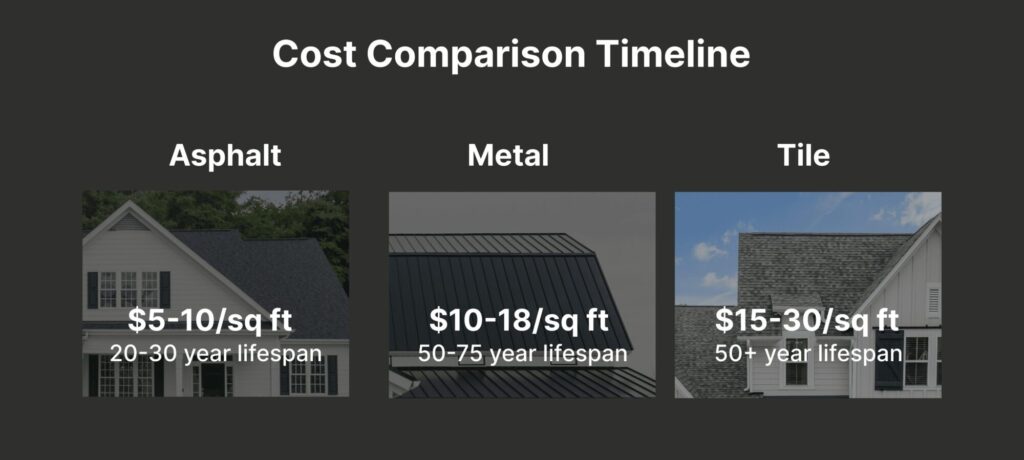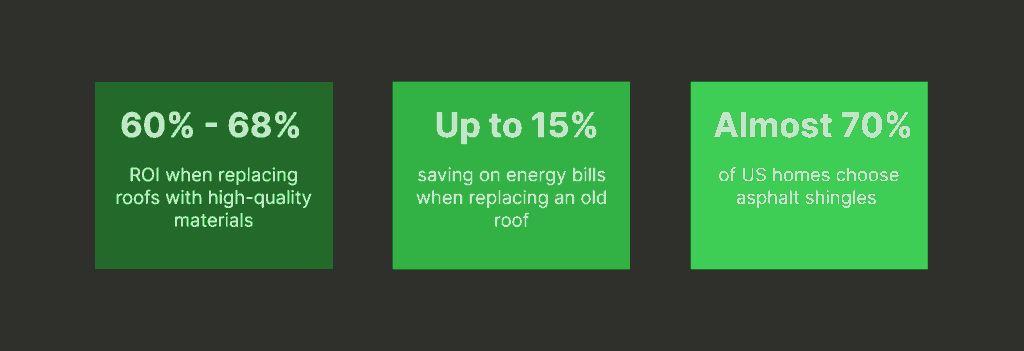Roof replacement is one of the biggest home investments you’ll make. In 2025, prices range widely based on materials, labor, and even the season you choose to install.
Whether you’re planning ahead or facing an urgent replacement, understanding the real costs helps you budget smarter.
We’ve installed thousands of roofs and know exactly where the money goes—and how you can keep more of it in your pocket.
Key Notes
- Roof size and complexity directly impact costs—more slopes mean higher labor expenses.
- Late fall/winter installations save up to 20% due to decreased demand.
- Regional factors like Northeast winterization and West Coast fire resistance affect material choices.
Overview: Roof Replacement Costs
| Material | Cost per Sq. Ft. | Lifespan | Key Benefits |
|---|---|---|---|
| Metal | $10 – $18 | 50 – 75 years | Durable, fire-resistant |
| Asphalt | $5 – $10 | 20 – 30 years | Affordable, easy to install, versatile |
| Tile | $15 – $30 | 50+ years | Long-lasting, fire-resistant, aesthetic |
Cost Breakdown by Roofing Material
Choosing the right material is a balancing act between upfront costs, durability, and aesthetics.
Let’s take a look at what you can expect to pay:
1. Metal Roofing
Metal roofing is durable and low maintenance. It can withstand harsh weather and offers a modern look.
This material resists rust, corrosion, and wear, so little roof maintenance is needed. A reflective coating on most metal roofs reduces heat absorption, making itl a good option for homeowners in hot climates.
As metal roofing is 100% recyclable, you know you’re making a sustainable choice.
- Materials: Steel, aluminum, copper, or zinc.
- Average Cost: $10 – $18 per square foot installed.
- Lifespan: 50 to 75 years.
Pros:
- Durable
- Energy-efficient
- Low maintenance
- Fire resistant
Cons:
- Higher upfront cost
- Noise during rain
2. Asphalt Shingle Roofing
Asphalt shingles are the most popular choice for roof replacement due to their affordability and versatility.
Asphalt is lightweight, yet durable, so only needs occasional inspections. Some modern designs include reflective technology to help regulate indoor temperatures and keep your energy bills in check.
These roofs are easy to install and come in a variety of styles to match any home.
- Materials: Standard or architectural shingles.
- Average Cost: $5 – $10 per square foot installed.
- Lifespan: 20 to 30 years.
Pros:
- Affordable
- Easy to install
- Widely available
- Often include recyclable materials for sustainable roofing
Cons:
- Shorter lifespan
- Less durable in extreme weather
3. Tile Roofing
Tile roofing offers a classic look with incredible durability. It’s fire-resistant and can last a lifetime, but its heavy weight needs a strong roof structure.
When properly installed, tile roofing allows for natural airflow, helping to keep your home cooler in summer. Tile is a popular choice for Mediterranean and rustic-styled homes.
Tile roofing is often made from reusable materials, making it a greener choice.
- Materials: Clay, concrete, or composite tiles.
- Average Cost: $15 – $30 per square foot installed.
- Lifespan: 50+ years, with slate lasting over 100 years.
Pros:
- Great curb appeal
- Fire-resistant
- Durable
- Resistant to rot and insects
Cons:
- Heavy (may need structural reinforcement)
- Expensive installation

How to Calculate Roof Replacement Cost per Square Foot
1. Measure Your Roof’s Square Footage
Measure the length and width of each roof section and multiply to get the square footage.
2. Account for Roof Pitch
If your roof is steep, multiply the square footage by a pitch factor (e.g., 1.2 to 1.5) to account for the extra surface area.
3. Choose Your Material
Different materials have different costs per square foot. Factor in both the material and installation costs.
4. Add Labor Costs
Labor can add $1.50 to $5.50 per square foot, depending on complexity and your location.
5. Include Additional Expenses
Don’t forget about old roof removal, permits, and possible structural reinforcements.

Regional Cost Estimates in the US
Roofing prices fluctuate based on where you live:
- Northeast: Higher labor costs, need for winterization
- South: Heat-resistant materials recommended
- West Coast: Fire-resistant roofing in wildfire zones
- Southeast: Moisture-resistant and storm-ready materials
Additional Costs to Consider
Here’s what else might hit your wallet:
Old Roof Removal
Expect to pay $1 – $5 per square foot to remove and dispose of old roofing materials.
Permits and Inspections
Depending on where you live, permits might set you back $150 to $500. Professional inspections can add to the cost but are worth it to avoid issues later on.
Structural Reinforcements
If you’re upgrading to heavier materials like tile, you may need structural reinforcement. Costs range from $1,000 to $10,000 depending on the scope of work.
Underlayment and Insulation
Adding underlayment and insulation can increase upfront costs but save money on energy bills.
Roof Pitch and Accessibility
Steep or hard-to-access roofs increase labor costs by 10% to 20%.
Ready For A Roof That Fits Your Budget?
Our pricing is transparent & our experts maximize your investment
Frequently Asked Questions
What time of year is the cheapest to replace a roof?
The cheapest time of year to replace your roof is late fall and winter when prices drop due to lower demand.
What is the best roof for your money?
Asphalt shingles provide the best balance of cost, durability, and ease of installation.
What is the life expectancy of a roof?
The life expectancy of a roof varies by material type with asphalt roofs lasting anywhere from 20 years and slate tile enduring the elements for up to 100 years.
Conclusion
Your roof isn’t just overhead protection—it’s a long-term investment in your home’s value, efficiency, and safety.
Materials matter: choose asphalt for budget-friendly protection (20-30 years), metal for decades of low-maintenance performance (50-75 years), or tile for century-long durability with classic appeal.
Smart timing (winter installations) and proper budgeting for removal costs, permits, and potential structural reinforcements prevent unexpected expenses. Factor in your climate, budget, and aesthetic preferences when making this significant decision.
Need help navigating all these options? We can provide a personalized cost estimate based on your home’s specific needs and your budget requirements. Contact us today for a free, no-obligation quote and make your roof replacement a stress-free investment.

